With a background in literature, Allison L. Wade has been carving out a visual vocabulary that references past and present experience while simultaneously establishing a consistent aesthetic vocabulary that explores contemporary tenets of abstraction. This can be seen in her recent exhibitions here in Chicago at Devening Projects, in Tokyo, Japan, at Hagiwara Projects, and presently at the Indiana University NW Art Gallery in Gary, Indiana. This week, the COMP Magazine visited Wade at her west Fulton Street studio to discuss her various travels, her current exhibit at IUNW, the role of titling works to offer an entry point to her works, and her role as an artist/educator.
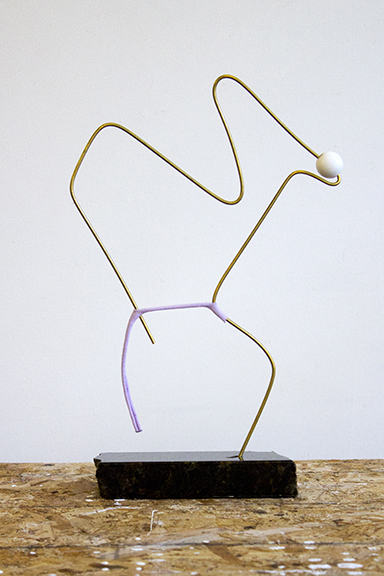
Allison L. Wade, Such large virtue, granite, brass, wood, hand-dyed fabric,
15 x 10 x 3 inches, 2016
You grew up in Texas, studied at Stanford University, Maryland Institute, and SAIC, and lived for a time in NYC. You’ve bounced around the country and landed in Chicago. Initially, your aesthetic interests resided in literature. I’m curious if you could identify what prompted you to shift your attention to exploring a visual vocabulary to convey your voice?
I’ve always been interested in the visual arts, but didn’t start focusing on it until I was in my mid-30s. My mom was an accountant, and while she always encouraged my artistic expression, she didn’t necessarily encourage art as a career path. I was a good student and was able to write well at a young age—creatively and expositorily—so that was nurtured and became my passion. As I got older, I lost touch with writing, but I never stopped taking continuing education classes in art. I realized I was able to express myself visually in a more unique and compelling way than with my writing. And I enjoyed the process a lot more.
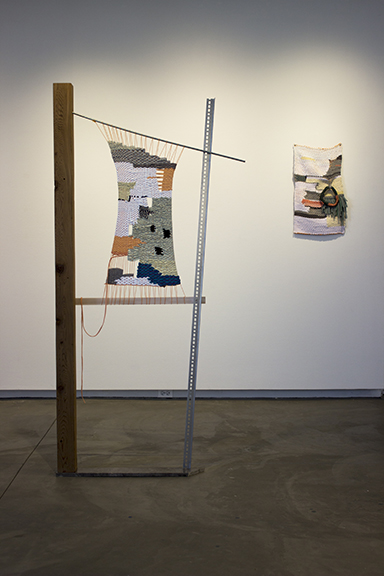
Allison L. Wade
On left: Assume Non-Empty Domains, granite, wood, stain, metal, mason line, hand-dyed knit, knit, 75 x 36 x 4 inches, 2016
On right: Untitled (Wall Weaving #2), ceramic, hand-dyed knit, knit,
27 x 15 x 2 inches, 2016
This past May you exhibited with Dan Devening, Paul Erschen, and Paul Stephan in Warm From Opens at Hagiwara Projects in Tokyo, Japan. Can you share with us your experience? How was it traveling with the boys?
Dan and Paul are excellent travel partners. I travelled with Dan to Berlin for a show back in 2014—he’s great at planning and knows people all over the world. Because of my teaching schedule, I arrived early with my partner, painter Cole Pierce, and we explored on our own. We ate a lot of amazing ramen, accidentally had dinner at a world-famous sushi restaurant, and checked out the best coffee shops in each neighborhood. There’s a huge artisanal coffee culture in Tokyo—totally unexpected—and each shop has to have its own twist, like a record-themed cafe near our Airbnb that gave away vintage albums if you purchased two bags of coffee. As for art, my favorite spot was the Japan Folk Crafts Museum. A show by the 96-year old textile artist (still working) Samiro Yunoki blew me away. We also made it to the flea market and picked up some gorgeous vintage textiles.
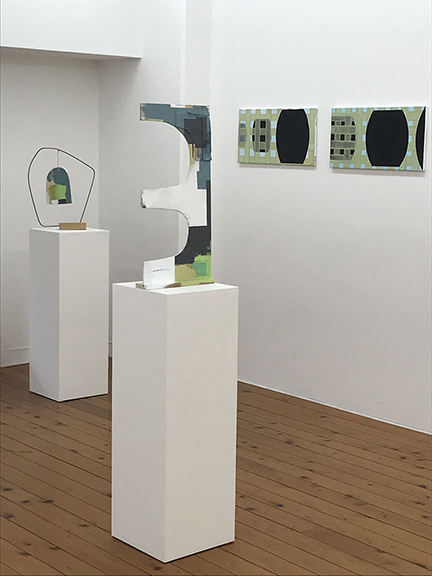
Allison L. Wade
On left: Untitled (Warm Front 4), wood, steel, hand-dyed fabric, paint, twine,
18 x 15 x 2 inches, 2018
Middle: Untitled (Warm Front 1), wood, hand-dyed fabric, paint, 25 x 12 x 3 inches, 2018
Two paintings on right are by Gary Stephan
Installed at Hagiwara Projects, Tokyo, Japan
You recently organized a solo exhibit, This That and the Other, at Indiana University in Gary, Indiana. Can you walk us through the process for creating works for this exhibit?
For the IUN show, I wanted to create a family of works that responded to the space and alluded to my layered process. The gallery is long and narrow with a low ceiling, so I kept that in mind from the beginning. I kicked off the process with a series of 30 or so ink-wash drawings. I then moved on to fabric wall hangings collaged together from hand-dyed and painted denim. Next came the sculptures, which started out a bit more restrained than normal because of the predominately geometric shapes and the use of painted wood as my main material. After setting up the work for a studio visit a month before the show, I realized I wanted the tone to be more playful. I reworked several of the sculptures with elements like pool noodles and brighter colors. I initially imagined they would be grouped in a central rectangle, but the sculpture needed more breathing room once in the gallery. This allowed for humor in the way the pieces occupied the space—five in a cluster in back, one holding court on its own, two bumping into each other…
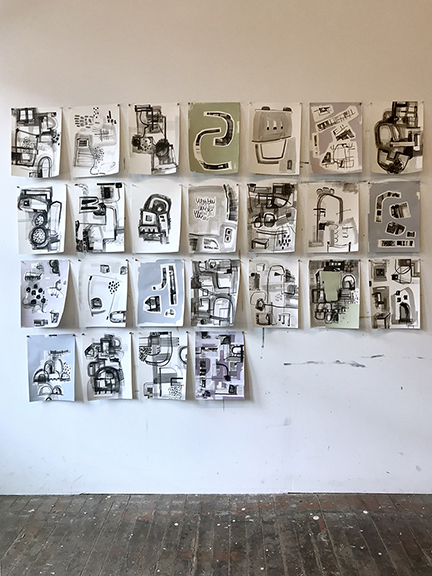
Allison L. Wade, Studio shot of paintings, ink wash and latex paint on paper,
all 15 x 11, 2018
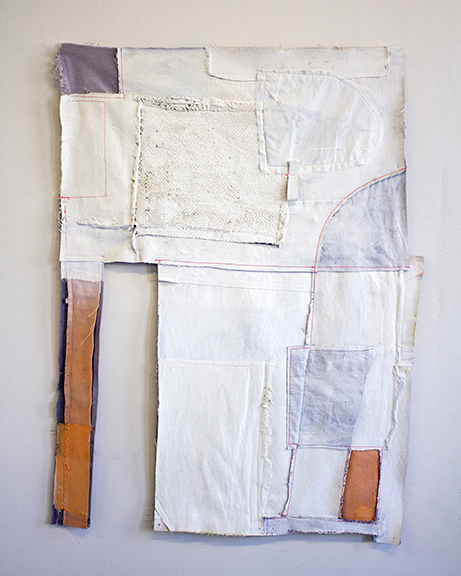
Allison L. Wade, Untitled, hand-dyed fabric, fabric, paint, 25 x 21 inches, 2018
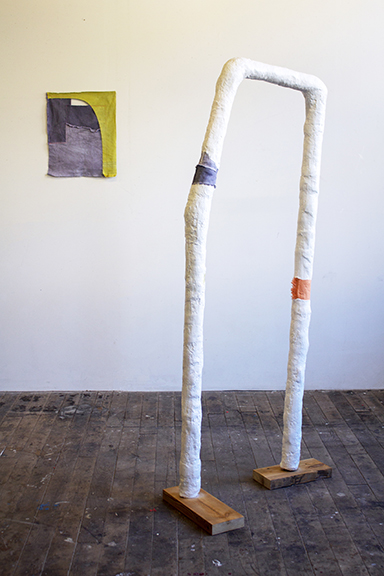
Allison L. Wade
On left: Untitled, hand-dyed fabric, 18 x 14.5 inches, 2018
On right: Untitled (The Other #1), wood, plaster, Sculptamold, hand-dyed fabric, paint, 64 x 27 x 14 inches, 2018
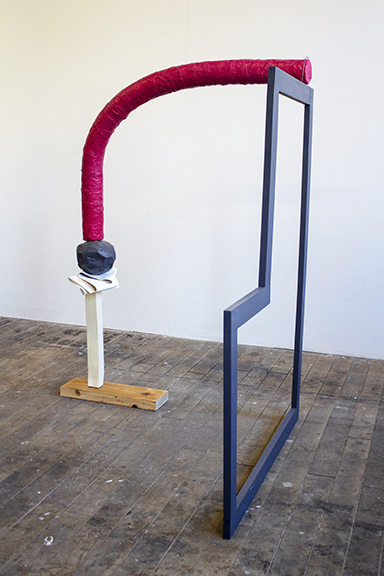
Allison L. Wade, Untitled (This #1), wood, metal, fabric, paint, ceramic,
papier maché, pool noodle, plaster strips, 49.5 x 36 x 36 inches, 2018
In looking at your artworks I sense a bit of opaqueness. I feel you are attempting to create a visual vocabulary connected to language as seen in literature? I want to know how the visual forms convey the titling of series and works. Can you describe the intersection of the tactile pieces to the selection of descriptive language in titling?
You are right about the visual language. It occurred to me in grad school that I could use materials, shapes, and forms to create my own syntax it in the same way that I used words. There’s an underlying logic to the way things fit together, but the logic is mine, and the rules can change. Maybe that’s where the opaqueness comes in. As far as titling goes, I aim for open rather than opaque. The work is at heart abstract, and I don’t want to dictate a particular reading. But I do want to indicate that a series belongs together. Hence, This That and The Other for the dozen sculptures that comprise the IUN show, or Know Better for the large sculptures in my last show at Devening Projects.
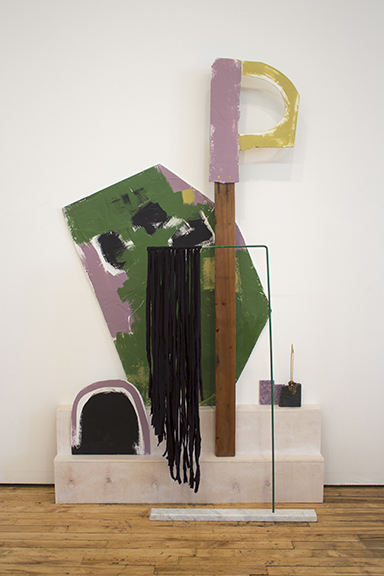
Allison L. Wade, Know Better: Scenario #1, wood, fiberboard, joint compound, papier maché, aluminum, fabric, hand-dyed fabric, paint, stain,
93 x 72 x 18 inches, 2016
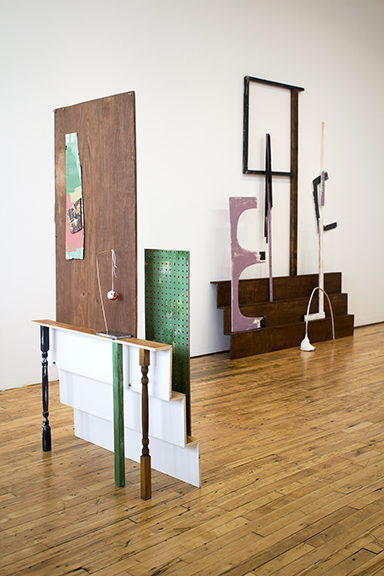
Allison L. Wade, Installation shot of Know Better
at Devening Projects, Chicago
In addition to your studio practice, you teach in the Department of Art Theory and Practice at Northwestern University. I’m curious if there are any specific items that you regularly share with your students?
I emphasize the idea that failure is a necessary and generative part of the artistic process. My job there is to introduce students to sculpture and drawing, but I find that many of them are stifled by a concern to get things “right.” They are such excellent students, so intelligent and engaged. It’s rewarding to see some of them shed self-judgment and embrace the process.
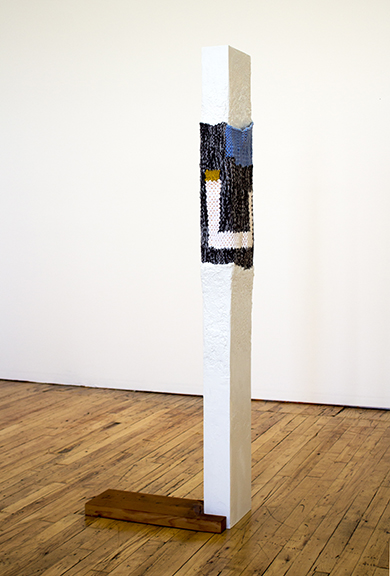
Allison L. Wade, Better luck this time, wood, hand woven fabric, Sculptamold, joint compound, paint, 60 x 9 x 19.5 inches, 2016, Collection of Scott Hunter
What do you value most in your studio practice?
Really good question. There are times that I arrive at the studio or to class still amazed that I get to do this for a living… I value the autonomy, and the fact that a self-directed artistic practice is a guarantee against boredom. I can always generate new questions for myself to solve.
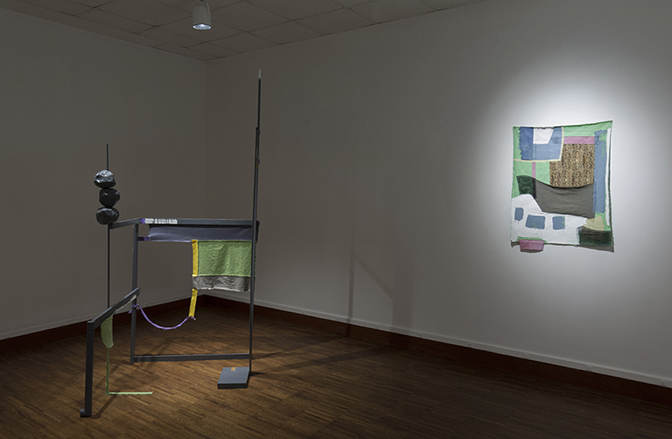
Allison L. Wade
On left: Whatever It Takes, wood, metal, papier maché, paint, hand-dyed fabric, snaps, 98 x 40 x 39 inches, 2017
On right: Ecstatic Ersatz, hand-dyed fabric, fabric, paint, 39 x 27 inches, 2017
Installed at Weston Gallery, Cincinnati, as part of a group show titled Unfunction
Image credit: Tony Walsh
With the current exhibition installed, what’s on the plate next? What are you currently working upon in the studio? Do you have any projects that you hope to complete or start before the end of 2018?
The sculptures for This That and the Other feel like the launch of a new direction. I normally don’t revisit work, unless it is to recycle materials for new sculptures. However, in this case, I want to grow this group of sculptures, add some new material elements and re-install them together in another space. I have a two-person show on the calendar for fall of 2019 at Nebraska Wesleyan, so perhaps there!
For additional information on the aesthetic practice of Allison L. Wade, please visit:
Allison L. Wade – https://www.allisonwade.com/
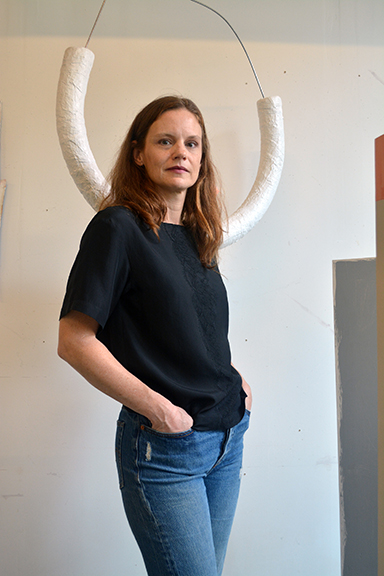
Allison L. Wade, artist, Chicago, 2018
Artist interview and portrait by Chester Alamo-Costello


